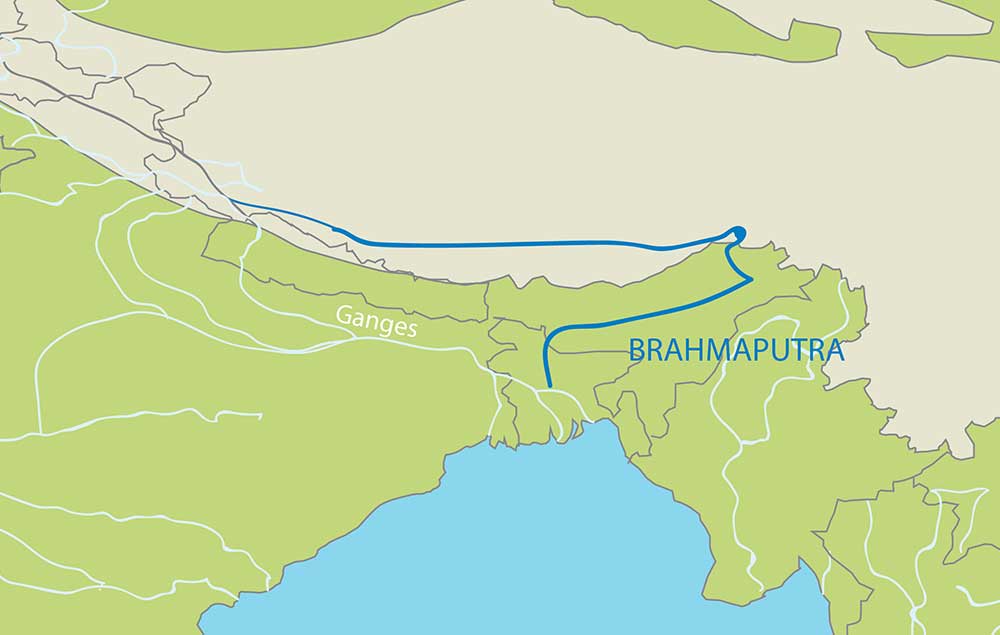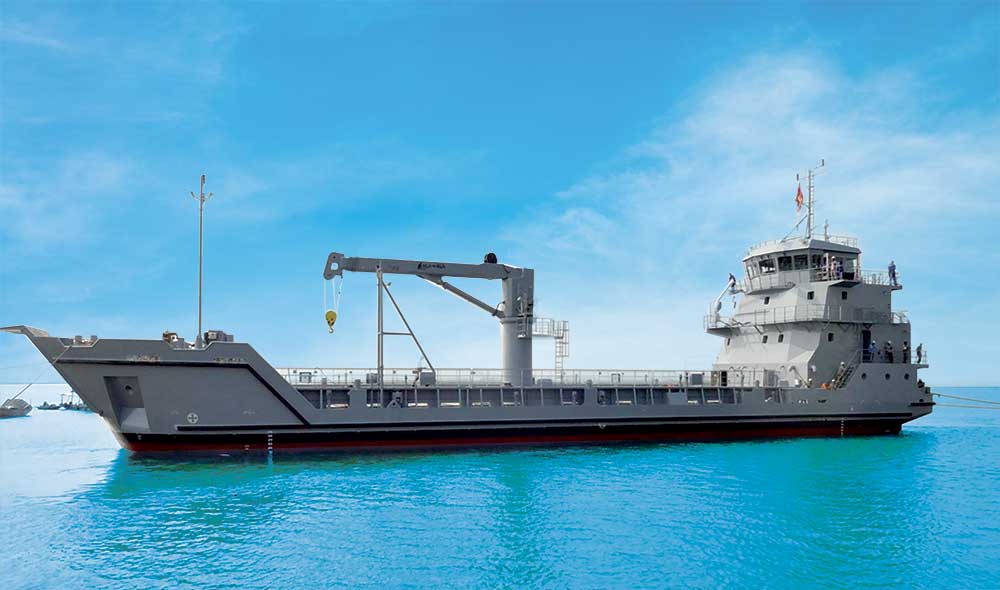Brahma means the “God of creation” as per Hindu mythology and “putra” refers to son, so Brahmaputra means the son of creator God. It is the only river in India bearing a male name. The river is around 2,900 km long and is considered as one of the longest rivers in the world. With an annual discharge of around 19,800 CBM per second (100,000 CBM per second during flood) at its mouth, the river Brahmaputra is the fourth biggest river in terms of discharge. The river originates in the “Angsi glacier” of the Himalayas in China and flows through the North East Indian state of Assam to join with the Ganges and Meghna rivers in Bangladesh before emptying into the Bay of Bengal. River Brahmaputra is known by different names during its journey. It begins as Yarlung Tsangpo in Tibet and becomes River Brahmaputra and Mahabahu Brahmaputra in India and finally culminates into being the Jamuna in Bangladesh.
Brahmaputra is navigable for most of its length in India. The government of India realized its immense navigational potential and declared it as the National Waterway-2 in 1988 between Sadiya and Dhubri.
Inland Water Authority of India (IWAI) is responsible for maintaining River Brahmaputra’s navigational channel with the required draft. The river carries about 735 million metric tons of suspended sediment loads annually hence continuous maintenance dredging is required to keep the channel navigable. The minimum river width is around 45 m across National Waterways -2(NW2) and the draft of 2.5 m between Dhubri – Neamati and 2.0 m between Neamati- Dibrugarh and 1.5 m between Dibrugarh – Sadiya is maintained throughout the year.
In order to facilitate seamless travel during the day and night, IWAI is working on providing necessary navigational aids. It has set up terminal facilities for loading and unloading at strategic locations like Dhubri, Pandu, and temporary facilities at Jogighopa, Silghat, Neamati and Dibrugarh. Pandu (Guwahati) is being developed as a multi modal transport hub which can serve the entire North East region. A permanent terminal at Dhubri, constructed with an approximate cost of Rs. 46 Cr is fully operational now. The existing Inland Water Transport (IWT) terminal at Jogighopa is proposed to be upgraded to a bulk cargo handling terminal for products like Meghalaya coal, with rail connectivity up to the terminal.
The potential cargo movements through NW2 include coal from Meghalaya, fly ash from Farakka to various destinations in the Northeast,limestone for cement plants, petroleum products from Numaligarh refinery, bitumen from Haldia, food grains from Kolkata, fertilisers, building material and bamboo. The other major cargo could be project cargo and machineries which shall arise from the ambitious power projects expected on various tributaries of the river Brahmaputra, particularly in Arunachal Pradesh.

Historically, the waterways of the Ganga and Brahmaputra were central to a flourishing trade in South Asia. Under British colonial rule, the rivers were neglected in favour of railways and road and later new political boundaries hindered cross border trade.
Though water is the major means of transport in Bangladesh, its scope is still hugely limited in India. With proper infrastructure, land locked countries like Bhutan and Nepal could also benefit from the development of inland navigation in India and Bangladesh.
A series of bilateral and multilateral agreements have been signed between India, Bangladesh and Bhutan which will work as a catalyst to trade along inland waterways. The key treaties were 1972 “Protocol on Inland Water Transit and Trade (PIWTT)” signed between India and Bangladesh where both the countries agreed for the transportation of goods and keeping their respective waterways navigable, while providing infrastructure facilities. The other major agreements between India and Bangladesh includes the 2016 and 2017 MOUs to allow tourists from Bangladesh and India to use coastal and protocol routes between countries. Bhutan also signed a MoU with Bangladesh in 2017 to use Bangladesh’s inland waterways for transportation of goods and services through Chittagong and Mongla ports for both imports and exports.
The India Bangladesh Protocol route (IBP) offers an alternate route of connectivity of North East India with mainland India bypassing Siliguri corridor. The connectivity of NWs through IBP route can ensure better hinterland connectivity between parts of Nagaland, Tripura, Manipur, Mizoram and Arunachal Pradesh and rest of India. Bangladesh and India are currently working together and investing on infrastructure and maintenance to keep their protocol routes navigable throughout the year for cargo ships of no less than 2,000 tonnes capacity.

The inland water transport departments of both the state and central governments of India are very keen to realize NW2’s full potential for cargo and passenger transportation. This can be achieved only by greater private participation. There is a huge investment opportunity for public private partnership (PPP) in areas like dredging, construction, operation and maintenance of barges, terminals, storage facilities, and navigation, as well as tourism. The recently concluded Assam Global Investors Summit showed great enthusiasm from private investors.
J M BAXI GROUP has realized the potential of using River Brahmaputra for cargo movements and has been effectively using it for ODC (Over Dimensional Cargo) movements for various prestigious clients. Some of the major movements undertaken by the group includes Numaligarh Refinery Project and Sibsagar Project. In both the cases, the cargo arrived at Kolkata port and were barged through River Brahmaputra to one of its tributaries called River Dhansiri where a jetty was provided and the packages were rolled off and carried to the site.
River tourism is another key potential area which can hugely contribute to the economy of the north eastern states. The presence of wild life sanctuaries at Kaziranga and Orang and tourist attractions like Sualkuchi, Sivsagar and Kamalabari along the River Brahmaputra attracts substantial tourists. The tourism prospects of this region can lead to inclusive development and economic opportunities as it relies heavily on local natural resources, culture, cuisine and art. If utilized effectively it has the potential to connect the BBIN (Bangladesh, Bhutan, India and Nepal) sub-region, which can bring overall economic prosperity for the region.
National waterways is cost efficient, enables an efficient logistics and is an environment-friendly mode of transport. The development of national waterway as a supplementary mode would enable diversion of traffic from over-congested roads and railways however the development has to be in sync with the larger connectivity development plans happening in the Bay of Bengal region. It is imperative to open up this isolated north east region of India to its neighbours and the rest of the world which will be possible only by way of an integrated transport plan with a focus on multimodal connectivity. This will ensure enormous gains in terms of economic growth, livelihood generation and prosperity, leading to political and social stability.